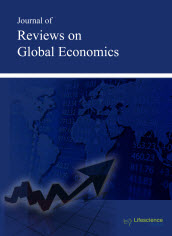jrge
Abstract - Some Problems on the Sectoral Structure, GDP Growth and Sustainability of Vietnam
|
|
Abstract: The Vietnam development has been enjoying a great deal of rapid economic growth in the last decades, which thank to the opening of market-oriented economy system. However, the economic growth is slowly recent years and the increase of environmental issues. The reason for this situation is that misallocation of resource, the sectoral development policies as well as the development orientation of the government. In order to find the solution, this research applies the input output model to analysis the sectoral structure and economic growth as well as the sustainability of economic growth and the effect of economics on the environment. Then, this research recommends the better sectoral structure for Vietnam in order to allocate resources efficiently and forward to the sustainable development. The purpose of this study was to point out the instability of Vietnam, not only for the environment but also for the whole economy.Research shows that VN is not only the face of environmental pollution, but also uncertainty about macroeconomic. It also pointed out the need to change the economic structure for economic development that the environment in a sustainable way. This research based on Leontief and Ghosh systems. Keywords: Economic, Environmental, structure, sustainability. |
Abstract - Modeling of the Aerial Capacity through a Leontief Production Function: The Case of Tunisian Airports
|
|
Abstract: Our objective is to model the airport capacity through a Leontief production function, which is based on the complementarity of the factors defining airport capacity. Results of our simulation for all Tunisian airports show that we can determine, especially, foreseeable future of the congestion, traffic processed by infrastructure, availability of infrastructures, the factors that block the circulation on the ground, and time measurements: delays, waiting time, and runway occupancy time. According to their capabilities (reduced, declared, optimal), three airports are identified. However, it is possible to avoid the extra costs experienced by the terminals and to optimize airports' capacity by making a reallocation of human resources and opting for a better exploitation of the existing infrastructures. Keywords: Airport Capacity, Availability, Modeling, Leontief Production Function, Tunisian airports. |
Abstract - Sustainable Development as a Macro-Regional Goal
|
|
Abstract: The idea of sustainable development emerged both from science and the environmental movement in the 70s and 80s of last century. Since then a lot was done in the field, sometimes without even naming it “sustainable development”, but a lot still remains to be done. In this paper we start from the consideration that sustainable development requires that we see our world as a system that connects space and any discussion today must first consider the enormous impacts that modern globalization trends are playing in shaping the economic geography of places, such as macro-regions. In the future, macro-regional development could be the most important platform for enhancing sustainability. The regional dimension is suitable for redefining the meaning of sustainable social, economic and environmental systems in a way which is practical and very close to the people and to the operative public decisions (Alkan Olsson et al. 2004). This paper is divided in different sections: the first is about the regional sustainable development concept and place-based approach; the second is about Local Agenda 21; the third about regional integration and developmental regionalism; the fourth is about regional sustainable development in practise and the European macro-regions; at the end some conclusive remarks concerns the macro-regional future strategies addressing sustainable development. Keywords: Sustainability, regional integration, territorial development. |
Abstract - Sustainable Development as a Macro-Regional Goal (2)
|
|
Abstract: The idea of sustainable development emerged both from science and the environmental movement in the 70s and 80s of last century. Since then a lot was done in the field, sometimes without even naming it “sustainable development”, but a lot still remains to be done. In this paper we start from the consideration that sustainable development requires that we see our world as a system that connects space and any discussion today must first consider the enormous impacts that modern globalization trends are playing in shaping the economic geography of places, such as macro-regions. In the future, macro-regional development could be the most important platform for enhancing sustainability. The regional dimension is suitable for redefining the meaning of sustainable social, economic and environmental systems in a way which is practical and very close to the people and to the operative public decisions (Alkan Olsson et al. 2004). This paper is divided in different sections: the first is about the regional sustainable development concept and place-based approach; the second is about Local Agenda 21; the third about regional integration and developmental regionalism; the fourth is about regional sustainable development in practise and the European macro-regions; at the end some conclusive remarks concerns the macro-regional future strategies addressing sustainable development. Keywords: Sustainability, regional integration, territorial development.Download Full Article |






















